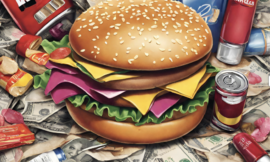In the field of economics, we have a habit of quickly forgetting previous tragedies, but understanding their causes and effects may teach us valuable lessons. In a world where economic policies and research are always changing. One thing that helps us navigate this uncertainty is history. A worldwide economic depression that began in 1929 and continued until around 1939. It was the longest and most severe depression ever experienced by the industrialised Western world. Although the Depression began in the United States, it caused huge drops in output, massive unemployment, and acute deflation in nearly every country on the planet.
The Soaring 1920s
In 1918 when the first world war finally came to an end America emerged victorious from the war and entered into a period of economic prosperity and cultural change known as the soaring 20s. The 1920s were a period of significant technological revolution that altered the fundamental structure of the economy, altered the character of the family, and challenged nineteenth-century social conventions. This boom was a combination of various factors such as troops coming back from the war, delayed projects were started again and more workers especially women joined the workforce which meant more people with incomes to spend. Capitalist companies wanted a piece of this disposable income and hence we had the first radio advertisement which promoted technologically advanced goods such as electric washing machines or vacuum cleaners. In 1907 only 8% of households had electricity, by 1930 68.2% were electrified. In good times, banks were giving loans to anyone and hence commodities were being sold like hot cakes such as Henry Ford’s T model car, all the increase in aggregate demand made companies very rich. Even the average American was doing well and hence people started looking for investment opportunities. The stock market seemed the perfect place which provided a market for investment and promising returns. With so many people investing, investors found it easy to make money off the stock market. Every person from a businessman to a shoe-shiner invested in the stock market to make some monetary gains. This craze was so acute that people borrowed to invest in the stock market. The banks enjoyed the interest and at the same time looked for investment opportunities themselves to park their money. In Fact there is much money to be made the banks borrow from the customer’s accounts and hence buy stocks. By 1929, investments had given a return of 218% from just 1922.
The Stock Market Crash of 1929
The stocks of companies were rising so fast that the companies were having a hard time keeping up production. Companies were hardly able to correlate the production data and the overly inflated stock prices. Soon macroeconomic indicators started showing slowdown in production. Henry Ford was not making as many cars, companies were not advertising their products as rigorously and the demand for products was decreasing. Soon the demand was at its saturation , firms overestimated their earnings which resulted in wages cuts which further led to decrease in that easy tax money. But as all this was happening the stock market was at an all time high. On October 24th 1929, which is known as the ‘Black Thursday’ as it is called, the theorised start of the great depression. The noises of production slowing down reached the investors on wall street which caused a panic. 12.9 million shares were sold that day, with Dow Jones falling a whopping 11%. It did not just stop there but on Tuesday or Black Tuesday the market tanked another 12% and this time 16.4 million shares were sold. The markets lost $14 billion dollars in a single day. Which led to people losing their life savings, people committing suicides and Americans and big banks alike who borrowed money were crushed in just a matter of a day. Which marked the beginning of the most economic downturn in the history of the modern industrialised world.
The Depression and it’s Cause and Effects
The Dow Jones fell continuously for three years and lost its 90% value from its high in 1929. Many lost their jobs, and companies got shut down. It was not only the investors that lost money but the banks who borrowed money from customers accounts to invest in the stock market bleeded mony. The average American was now only getting 10 cents per dollar he put into the bank. Unemployment reached its highest point in US history 24.9 percent of the population was unemployed, soup kitchens and people on the streets were a common sight. If you invested money in the stock market, put it into the bank or just kept cash. This depression found its way to hurt you financially. Banking failure was one of the main causes of the downturn. Banks were small and independent institutions that had to rely on their own resources at the time. As a result of the panic, people hurried to withdraw their money, and banks were unable to keep up with the increased demand for money. People’s desire to hold cash increased dramatically in relation to their bank accounts as a result of the panics. This increase in the currency to deposit ratio was a major reason why the US money supply fell by 31% between 1929 and 1933. In 1930, there was a large wave of bank failures, and to fulfil the need for money, banks called upon loans and liquidated assets, causing money in circulation to become limited and deflation to occur. When prices fell, businesses cut costs by laying off workers, which meant less money for customers to spend. Banks also stopped lending money, so businesses couldn’t borrow to cover their expenses, thus many businesses failed and prices were unable to rise. Andrew Jackson who was the president of the USA from 1829-1837 distrusted the central banking system, it can be said that because of the lack of a central bank the banking failure occurred. But the federal reserve also should receive the blame for not infusing money in the economy or rescuing the banks to combat this deflationary cycle. But instead took poor policy decisions, in September 1931, when Britain was pushed off the gold standard and investors feared that the United States would follow suit, the Federal Reserve purposely reduced the money supply and hiked interest rates. This posed another challenge to the money supply and as a result a strong economic policy was required.
Recovery
After the failings of Franklin D. Roosevelt’s ‘New Deal,’ it would not be until the establishment of the Third Reich in Germany that the situation would be resolved. Because of recent globalisation, the effects of the Great Depression were felt all over the world, and in the midst of the darkness, we saw the rise of Hitler, who used the despair of the German people as a rallying cry, eventually leading to the formation of the Nazi Party and the start of the Second World War. Which increased aggregate demand for war materials, causing production to double. Because of the draft, unemployment fell from 17 percent in 1939 to 1 percent in 1944, while the United States produced more commodities than its enemies combined in 1994. Women went to work in factories to fill the voids and the labour unions held more power to avoid wage cuts.After the second world war American companies started to make luxury goods as before but after the war there was the ‘Baby Boom’ so aggregate demand was rising rapidly. The second world war killed millions but at the same time ended the great depression “It is, it seems, politically impossible for a capitalistic democracy to organise expenditure on the scale necessary to make the grand experiments which would prove my case – except in war conditions”- John Maynard Keynes.
Our Takings from The Great Depression
In 1939, the war created jobs in America ironically ending one tragedy with the start of another experts can’t agree on why the Great Depression was as bad as it was but the were valuable takeaways from the hardship it demonstrated just how powerful the greed and alternatively the fear of the markets can be when they get out of control while demonstrating the destructive potential of speculation and debt laws would later be introduced to safeguard financial institutions and deposits during his time in office Franklin D Roosevelt would introduce the Federal Deposit Insurance Corporation and the Securities Exchange Commission institutions targeted at protecting the wealth of Americans that still exists to this day few are left to remember the hardships of the depression but we’d be foolish to forget the lessons it provided after all fear greed and speculation are far from dead.


